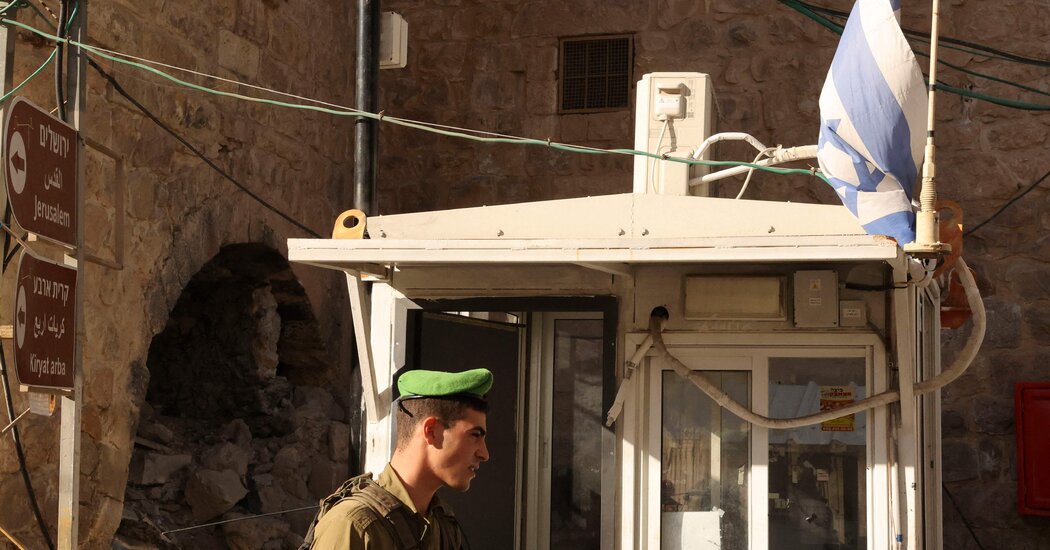
 Technology
Technology 
Israel is increasingly relying on facial recognition in the occupied West Bank to track Palestinians and restrict their passage through key checkpoints, according to a new report, a sign of how artificial-intelligence-powered surveillance can be used against an ethnic group.
At high-fenced checkpoints in Hebron, Palestinians stand in front of facial recognition cameras before being allowed to cross. As their faces are scanned, the software — known as Red Wolf — uses a color-coded system of green, yellow and red to guide soldiers on whether to let the person go, stop them for questioning or arrest them, according to the report by Amnesty International. When the technology fails to identify someone, soldiers train the system by adding their personal information to the database.
Israel has long restricted the freedom of movement of Palestinians, but technological advances are giving the authorities powerful new tools. It is the latest example of the global spread of mass surveillance systems, which rely on A.I. to learn to identify the faces of people based on large stores of images.
In Hebron and East Jerusalem, the technology focuses almost entirely on Palestinians, according to Amnesty’s report, marking a new way to automate the control of interior boundaries that separate the lives of Palestinians and Israelis. Amnesty called the process “automated apartheid.” Israel has strongly denied that it operates an apartheid regime.
“These databases and tools exclusively record the data of Palestinians,” said the report, which is based on accounts by former Israeli soldiers and Palestinians who live in the surveilled areas, as well as field visits to observe the technology’s use in affected territories.
The Israel Defense Forces, which plays a central role in the occupied territories of the West Bank, said in a statement that it carries out “necessary security and intelligence operations, while making significant efforts to minimize harm to the Palestinian population’s routine activity.”
On facial recognition, it added, “Naturally, we cannot refer to operational and intelligence capabilities.”
Government use of facial recognition technology to so explicitly target a single ethnic group is rare. In China, companies have made algorithms that sought to identify minorities as they passed by the country’s ubiquitous cameras. China’s government has also used facial recognition checkpoints to control and track the movements of Uyghurs, Kazakhs and other ethnic minorities.
Israel’s use of facial recognition at checkpoints builds on other surveillance systems deployed in recent years. Since protests in the East Jerusalem neighborhood of Sheikh Jarrah over the eviction of Palestinian families in 2021, the presence of cameras has increased in the area, most likely supporting an Israeli government video surveillance system capable of facial recognition known as Mabat 2000, according to Amnesty.
In one walk through the area, Amnesty researchers reported finding one to two cameras every 15 feet. Some were made by Hikvision, the Chinese surveillance camera maker, and others by TKH Security, a Dutch manufacturer.
TKH Security declined to comment. Hikvision did not respond to a request for comment.
Government forces also use the cameras on their phones. Israeli authorities have a facial recognition app, Blue Wolf, to identify Palestinians, according to Breaking the Silence, an organization that assisted Amnesty and collects testimonials from Israeli soldiers who have worked in occupied territories.
Soldiers use the app to photograph Palestinians on the street or during home raids to register them in a central database and to check if they are wanted for arrest or questioning, according to the 82-page Amnesty report and testimonials from Breaking the Silence. Use of Blue Wolf was reported earlier by The Washington Post.
The surveillance is partly an effort to reduce violence against Israelis. This year, Palestinian attackers have killed 19 Israelis. At least 100 Palestinians this year have been killed by Israeli security forces, many during gunfights that broke out during military operations to arrest Palestinian gunmen. Israel has occupied the West Bank since 1967 after capturing it from Jordan during the Arab-Israeli war that year.
Issa Amro, a Palestinian activist in Hebron, a West Bank city where there is regular violence, said people are under constant surveillance. He, his friends and family are regularly stopped by soldiers to be photographed using the Blue Wolf app. Surveillance cameras line the streets and drones commonly fly overhead.
Mr. Amro said the Israeli military has become so dependent on the automated systems that crossing the checkpoints grinds to a halt when there are technical problems.
“Everything is watched. My whole life is watched. I don’t have any privacy,” he said. “I feel they are following me everywhere I go.”
Mr. Amro said Palestinians are angry that the surveillance tools never seem to be used to identify crimes by Israeli settlers against Palestinians.
Ori Givati, a former Israeli tank commander who is now the advocacy director of Breaking the Silence, said the new surveillance systems began being put in place around 2020. The technology has allowed the Israeli government to move toward an automated occupation, he said, subjecting Palestinians to constant oversight and supervision.
The facial recognition systems, he said, are “not just as an invasion of privacy but a powerful tool for control.”
24World Media does not take any responsibility of the information you see on this page. The content this page contains is from independent third-party content provider. If you have any concerns regarding the content, please free to write us here: contact@24worldmedia.com